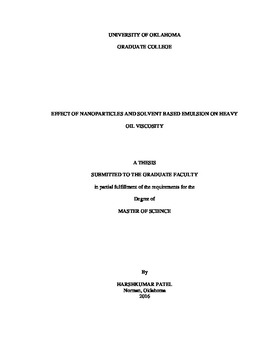| dc.description.abstract | Considering the fact that heavy oil and bitumen constitutes about 70% of world’s total oil resources, it is not surprising that the quest to produce heavy oil has attained industry wide attention. Because of extremely high viscosity, heavy oil reservoirs generally yield low-energy and low-productivity wells. Technical and economic challenges associated with heavy oil production, indicate a need for extensive research and development activities.
The objective of study presented in this document is to investigate three different approaches for reducing viscosity of heavy oil. In the first set of experiments, three types of metal oxide nanoparticles (CuO, Fe2O3, and NiO) were employed and their effect on heavy oil viscosity was investigated at different concentrations. The second approach was to mix a solvent-in-water (S/W) emulsion with heavy oil sample in different proportions and inspect rheological changes in resultant emulsion. In third phase of the study, both nanoparticles and solvent based emulsion were added to heavy oil sample and viscosity of resultant nano-emulsion was examined. For all test fluids, rheological measurements are presented at four different temperatures ranging from 100°F to 160°F. This unprecedented experimental work was conducted with two extremely viscous heavy oil samples having viscosity of approximately 77,000 cP and 350,000 cP at room temperature.
Addition of nanoparticles resulted in notable reduction in viscosity of both heavy oil samples. For each type of nanoparticles, viscosity reduction of 50 to 70% was achieved. The degree of viscosity alteration was observed to be a function of type of nanoparticles, their concentration, and fluid temperature. Moreover, optimum concentrations for maximum viscosity reduction, were identified for each metal oxide nanoparticles at different temperatures.
Using S/W emulsion, depending on volume fraction, viscosity reduction varying from 20 to 93% was achieved. In case of S/W emulsion containing nanoparticles, viscosity alteration strongly depended on type of nanoparticles added. Addition of copper oxide nanoparticles in S/W emulsion resulted in additional viscosity reduction of 10 to 30%. Iron oxide nanoparticles had adverse effect, if any, on the performance of S/W emulsion. Interestingly, nickel oxide nanoparticles either had improving or deteriorating effect depending on its concentration in S/W emulsion.
Cost analysis revealed that some of the test fluids cost less than $16 per barrel of oil and provided 40 to 50% viscosity reduction. The results are promising considering the fact that the cost presented were calculated based on purchase quote for a very small quantity and they will reduce significantly for field scale applications.
Remarkable results obtained in this study, confirm efficacy of nanoparticles and solvent based emulsion in reducing viscosity of heavy oil. This work rekindles the interest in non-thermal heavy oil recovery techniques such as chemical flooding, and provides a foundation for future core flooding studies. | en_US |
